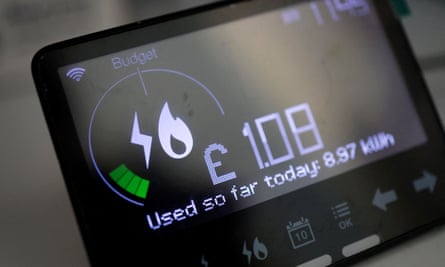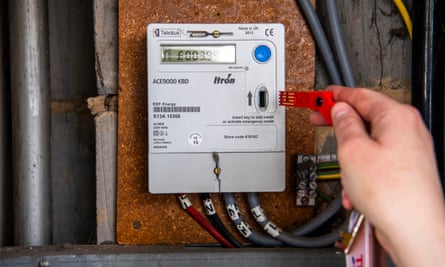Sky-high bills have made the price cap set by the energy regulator Ofgem a key number for British households. The good news is that from Sunday the cost of the average annual dual-fuel bill in Britain will drop below £2,000 a year for the first time since April 2022 as a new, lower cap kicks in.
The bad news is there is no repeat of the £400 universal bill subsidy this year, and the End Fuel Poverty Coalition says the financial squeeze created by the ongoing cost of living crisis means “people will still feel the pain of high energy bills this winter”.
How is the cap changing?
On 1 October, the price cap set by Ofgem for households in England, Wales and Scotland is being reduced to £1,834 a year for a typical annual dual-fuel energy bill, from its previous figure of £2,074.
A large part of that reduction is down to a change in how the regulator calculates how much gas and electricity the average household consumes in a year. Using the old methodology, the cap will only fall by 7%, or £151, to the equivalent of £1,923 a year. For customers who have prepay meters or pay by cash or cheque, that figure is slightly higher, at £1,949 and £2,052 respectively.
The £1,834-a-year cap covering October to December is based on new Ofgem calculations that assume households now use 7% less electricity and 4% less gas, having cut back consumption in the cost of living crisis. When it was announced last month, the regulator gave a headline figure of £1,923 a year, using the old methodology to help comparisons with previous quarters. In future, only the new system will be used.
 View image in fullscreenThe cap dictates the maximum a supplier can charge for each unit of energy as well as the maximum daily standing charge. Photograph: Tolga Akmen/AFP/Getty Images
View image in fullscreenThe cap dictates the maximum a supplier can charge for each unit of energy as well as the maximum daily standing charge. Photograph: Tolga Akmen/AFP/Getty Images
So will I pay no more than £1,834 this year?
Not necessarily. That is just how much a “typical” household would pay for its energy if the new rate were applied for a full year. The cap dictates the maximum a supplier can charge for each unit of energy as well as the maximum daily standing charge (flat daily fees, often likened to line rental for a phone, that are charged for a gas and electricity connection regardless of how much or little energy people use). Bills could be higher or lower because they are based on your actual usage rather than average consumption.
Moreover, the level of the Ofgem cap changes every three months. On Friday, the leading forecaster Cornwall Insight predicted the rate would climb to £1,898 a year for the typical home from January.
How does the cap work?
When it was created in 2019, the cap set out to help customers on their supplier’s standard variable or “default” tariff, ensuring they were not ripped off as a result of sticking with the same supplier year after year. But the energy crisis changed all that: about 30 suppliers went bust and cheap fixes and the switching market disappeared.
Now about 29 million households sit on a default tariff whose level is dictated by the cap. Suppliers are restricted in how much they can charge for each kilowatt hour (kWh) of electricity and gas (the units your bill is calculated from), and also standing charges.
In the current period up to close of play on Saturday, a customer paying by direct debit or through a prepayment meter is charged a maximum of 30p a kilowatt hour (rounded to the nearest penny) and 8p a kWh for gas. From 1 October, those will fall to 27p and 7p respectively.
Meanwhile, average daily standing charges, now at 52.97p for electricity and 29.11p for gas, will nudge up to 53.37p and 29.62p, or a total of 83p from October. Standing charges vary by region, with energy users in Merseyside and north Wales, for example, paying substantially more than those in south-east England.
While falling unit costs are good news for households, the cost of every unit of energy used is still about double what it was two years ago. Meanwhile, standing charges are up 8% for gas and a whopping 119% for electricity. Standing charges now add up to just over £300 for the average billpayer.
 View image in fullscreenThe cap for people on repayment meters is slightly higher than for those paying by direct debit. Photograph: Jill Mead/The Guardian
View image in fullscreenThe cap for people on repayment meters is slightly higher than for those paying by direct debit. Photograph: Jill Mead/The Guardian
Does the cap protect people on prepayment meters?
Yes. The energy costs of about 4 million domestic customers with energy prepayment meters who pay upfront for gas or electricity using an app or by visiting a shop are protected by the cap but it is still a slightly higher figure than for those paying by direct debit.
They used to face a bigger “prepayment premium” until the government stepped in to end it. It is funding a reduction in the gap until April 2024, with Ofgem working on a plan to eradicate it permanently after that.
Why are heat network customers out in the cold?
Customers who live in flats with communal heating systems are supplied by a single supplier that procures energy on their behalf. As a result, their supply is considered to be commercial rather than domestic and is not controlled by the cap.
Heat network operators, such as local councils, can apply for help with costs through the government’s energy bill discount scheme. Savings are supposed to be passed on to consumers, and if your supplier secures a discount they must contact you to tell you how they will pass it on to you.
If you have not received notice and you think you should have, you can complain. You can contact your supplier using a template letter on Gov.uk. If you do not hear back within eight weeks, complain to the energy ombudsman.
What help is available?
Less than before. The £400 energy support given to all households is not being repeated this year, with the government instead making cost of living payments to about 8 million vulnerable households. This includes a £900 payment for those on means-tested benefits, £300 for pensioners and £150 for disabled people.
If you are struggling, contact your supplier as soon as you can. Under Ofgem rules, suppliers must work with you to agree on a payment plan you can afford. There are different things you should do if you cannot afford to top up your prepayment meter. You should be able to get temporary credit from your supplier. Other options include applying for an energy grant.



